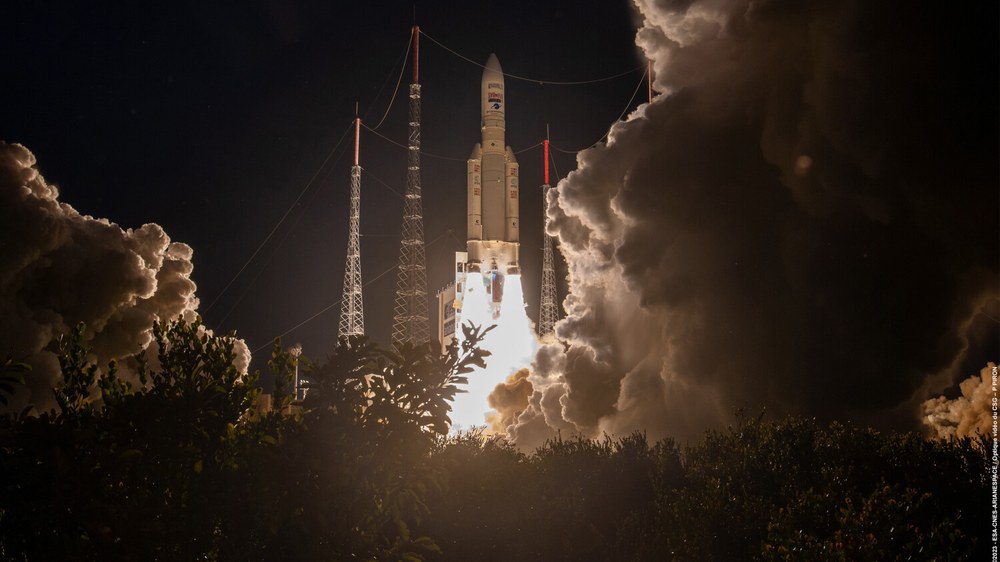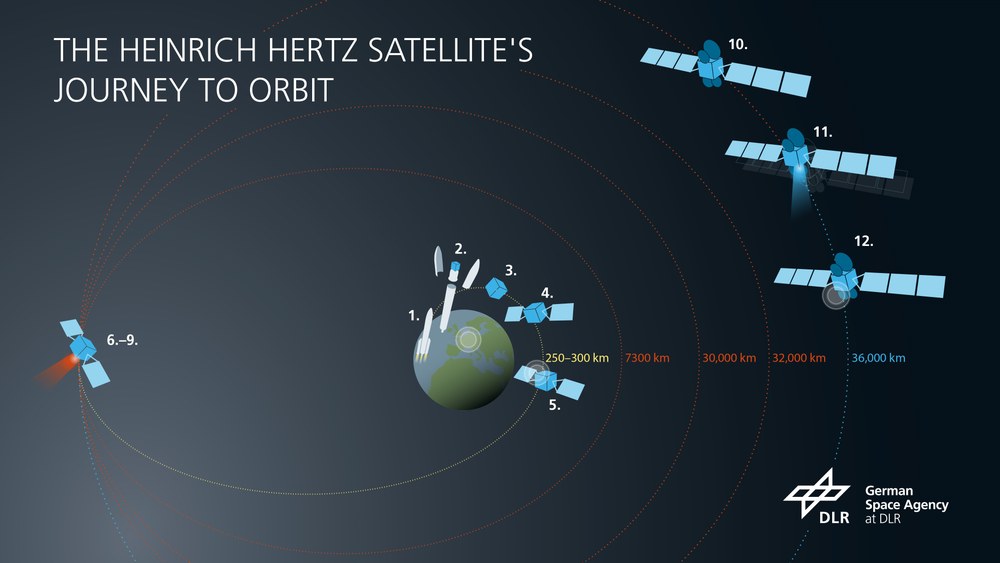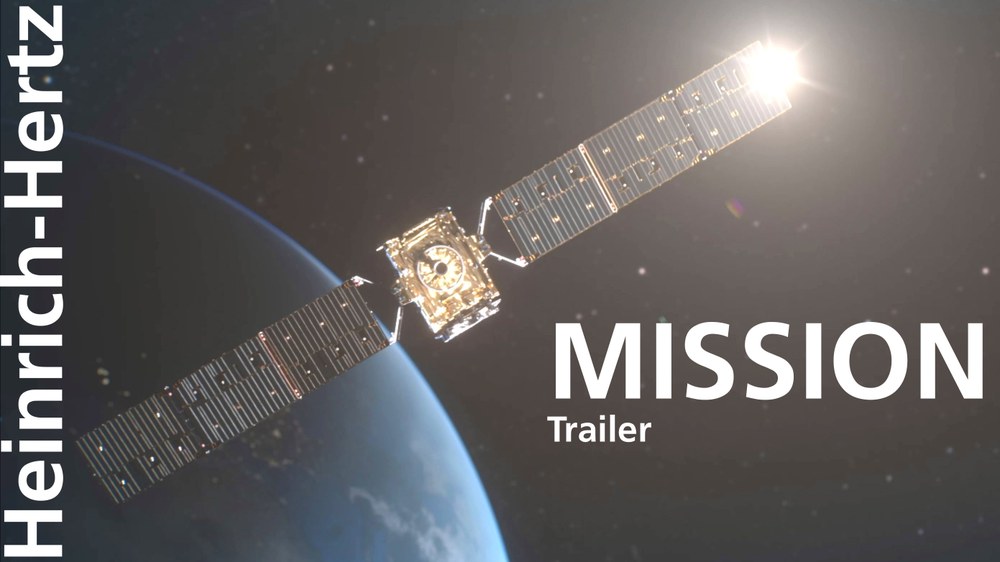Final Ariane 5 flight will carry German communications satellite into space



- On 16 June 2023, the German Heinrich Hertz communications satellite is scheduled to be carried into orbit on board the last Ariane 5 launcher.
- The Heinrich Hertz mission is managed by the German Space Agency at DLR in Bonn on behalf of the Federal Ministry for Economic Affairs and Climate Action (BMWK) and with the participation of the Federal Ministry of Defence (BMVg).
- The Heinrich Hertz mission will give a strategic stimulus to Germany as a technology location for satellite communications.
- Focus: Spaceflight, satellite communications, launch systems
+++ The Ariane 5 launcher with the German communications satellite Heinrich Hertz and the French military satellite Syracuse 4B on board successfully lifted off at 00:00 CEST on 6 July 2023. +++
On 16 June 2023, the time will have come. The final European Ariane 5 launcher is scheduled to lift off at 23:26 CEST (18:26 local time) from the European Spaceport at Kourou in French Guiana, carrying the German communications satellite 'Heinrich Hertz' and the French military satellite 'Syracuse 4B' into orbit. The 117th Ariane 5 flight, VA261, will release the Heinrich Hertz satellite into a geostationary transfer orbit. From there, the satellite will use its thrusters to transition into geostationary orbit and reach its target position at 0.5 degrees east, which is expected to be accomplished by early July 2023.
Heinrich Hertz will then have arrived at an altitude of approximately 36,000 kilometres in the equatorial plane and will always be situated above the same point on Earth's surface. This is located a little south of Ghana in the Atlantic Ocean. The Heinrich Hertz mission is being managed by the German Space Agency at German Aerospace Center (Deutsches Zentrum für Luft- und Raumfahrt; DLR) on behalf of the Federal Ministry for Economic Affairs and Climate Action (Bundesministerium für Wirtschaft und Klimaschutz; BMWK) and with the participation of the Federal Ministry of Defence (Bundesministerium der Verteidigung; BMVg).
"With the final lift off of an Ariane 5 launch vehicle, an era in this sector is coming to an end, while a new one in German satellite communications is beginning. The Heinrich Hertz mission will put German industry in a position to compete on an equal footing in international telecommunications. With its systems capability in the highly competitive communications satellite market, Germany is taking a decisive step towards shaping its own programmes in this sector and qualifying for a leading role in European programmes such as the IRIS² connectivity initiative," emphasises Walther Pelzer, Member of the DLR Executive Board and Director General of the German Space Agency at DLR.
Heinrich Hertz mission – enhancing Germany as a location for space activities
The Heinrich Hertz mission is providing a significant stimulus to the telecommunications satellite market in Germany and the country's position a leading technology location. The prime contractor and system integrator is OHB System AG in Bremen, while Tesat-Spacecom GmbH & Co. KG in Backnang is responsible for payload integration. In addition, 40 further industrial and research partners were involved. The development of this supplier ecosystem benefits the space economy in Germany in all its diversity. In addition, numerous European companies are involved in the project.
The findings from the Heinrich Hertz mission, together with other technological developments, can also be transferred to smaller, low-flying satellites, which are manufactured cost-effectively and in series production. The Heinrich Hertz mission is also an important step in the field of what are referred to as smart satellites. The results of the mission can help to further advance the increased flexibility and digitalisation of satellite communications technologies and prepare for contemporary topics such as artificial intelligence, quantum communications and flexible antenna technology for megaconstellations.

Video: The Heinrich Hertz communications satellite
Your consent to the storage of data ('cookies') is required for the playback of this video on Youtube.com. You can view and change your current data storage settings at any time under privacy.
The video is also available on Vimeo.
Ariane 5 – a legend retires
What will end with the launch of the Heinrich Hertz mission began 27 years ago. On 4 June 1996, the first launch marked the birth of Ariane 5. While the first flight was a false start, Ariane 5 developed over the following 27 years into one of the most reliable and safest launch vehicles, with 111 successful launches to date out of a total of 116. Thus, Ariane 5 was the guarantor of Europe's independent access to space for almost three decades. With the launch of the space telescopes XMM-Newton (1999) as well as Herschel and Planck (2009), the exploration of the origin and development of the universe could be significantly advanced.
Ariane 5 launched Rosetta and Philae (2004), the first mission ever to make a soft landing on a comet. The launching of the European Automated Transfer Vehicle space transporters (ATV-1 to ATV-5) ensured the delivery of supplies to the International Space Station from 2008 to 2015 and also helped to pave the way for Europe's participation in the Artemis programme.
In addition, Ariane 5 put ESA's JUpiter ICy moons Explorer (JUICE) spacecraft on course for Jupiter on 14 April 2023. But it is not only institutional launches that have sent the workhorse of European spaceflight into space. Almost 150 commercial satellites and twelve Galileo satellites were safely and reliably launched with Ariane 5.
"Ariane 5 is the most successful European launch vehicle. The launch of the James Webb Space Telescope makes this particularly clear. NASA entrusted us Europeans with launching the largest and most expensive space telescope of all time. And Ariane 5 launched James Webb with such pinpoint accuracy that the telescope needed to use significantly less of its own propellants to reach its target location. This will make it possible for scientists to take measurements with the telescope for much longer than the planned ten years. In order to continue this success story of the Ariane launcher and to maintain Europe’s access to space, we must now start Ariane 6 operations as quickly as possible," says Walther Pelzer.

Animation: Heinrich Hertz - Innovation, communication, geostation
Your consent to the storage of data ('cookies') is required for the playback of this video on Youtube.com. You can view and change your current data storage settings at any time under privacy.
The animation is also available on Vimeo.
Ariane – a European launcher with German roots
The history of the European Ariane launchers is also a German success story. ArianeGroup in Bremen is responsible for the construction of all Ariane 5 upper stages. Part of the production and integration of the stages, including the Vehicle Equipment Bay (VEB), which also houses the on-board computer, also takes place there. ArianeGroup in Ottobrunn supplies the 'heart' of the main and upper stage engines with the combustion chambers and other propulsion technologies. MT Aerospace in Augsburg builds essential structural elements such as tank vents and booster housings. The DLR Institute of Space Propulsion in Lampoldshausen is one of two locations in Europe where the liquid-propellant engines of Ariane 5 and Ariane 6 are thoroughly tested. There are also numerous German suppliers and subcontractors.
The Heinrich Hertz Mission and its partners
The Heinrich Hertz mission marks the first launch of a dedicated German communications satellite for researching and testing new technologies and communications scenarios. The mission will thus make an important contribution to Germany's information society. The Heinrich Hertz mission is being managed by the German Space Agency at the German Aerospace Center (Deutsches Zentrum für Luft- und Raumfahrt; DLR) in Bonn on behalf of the Federal Ministry for Economic Affairs and Climate Action (Bundesministerium für Wirtschaft und Klimaschutz; BMWK) and with the participation of the Federal Ministry of Defence (Bundesministerium der Verteidigung; BMVg). OHB System AG was contracted to develop and build the satellite. The companies IABG GmbH, MDA AG and TESAT GmbH & Co. KG are also involved in the development and testing of the satellite. OHB Digital Connect is responsible for the ground segment in collaboration with CGI. The satellite control centre is located in Bonn. The locations for the mission's new ground stations are in Hürth (North Rhine-Westphalia) and Neustrelitz (Mecklenburg-Western Pomerania). Arianespace is responsible for launching the mission on board an Ariane 5 launch vehicle (VA261). A total of 42 partners are involved in the mission – 14 of them on the scientific payload.
The launch of the Heinrich Hertz satellite on the last Ariane 5 can be watched on the Arianespace YouTube Livestream from 22:26 CEST on 16 June 2023.
Video footage
- Heinrich Hertz Mission animation (Cleanfeed)
- Statements by Walther Pelzer (DLR Executive Board Member and Director General of the German Space Agency at DLR) on the Heinrich Hertz mission (in German)
- Footage/B-Roll of Heinrich Hertz Mission: Antennas in Hürth, near Cologne
Location: Three of the antennas used for the Heinrich Hertz mission are located in Hürth, near Cologne. These antennas are used to send commands to and receive data from the satellite. - Footage/B-Roll of Heinrich Hertz satellite (Arrival in Cayenne, Transport to Kourou, Cleanroom Kourou)
Location: On 27 April 2023, the German communications satellite was flown from Leipzig to Cayenne in French Guiana on an Antonov aircraft. It was then transported from Cayenne to Kourou by truck. Upon arrival at the European Spaceport (Centre Spatial Guyanais; CSG), the satellite transport container was brought into the facility’s airlock, an anteroom to the clean room, and the satellite was removed from the container.
Related article
